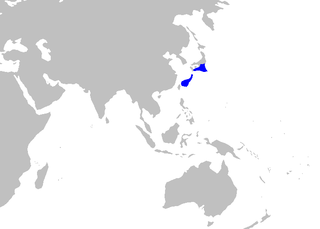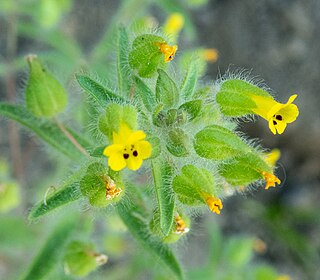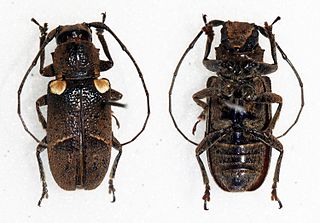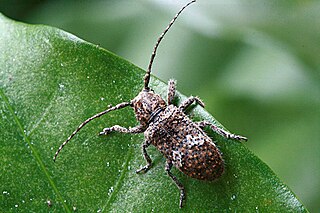The large Palau flying fox is an extinct species of medium-sized megabats from the Palau Islands in Micronesia. It had brownish fur with long, silvery hairs on its belly, and a wingspan of about 60 cm. It probably became extinct around 1874, possibly due to overhunting. It is known from two specimens, one of which is in the Natural History Museum, London.

Sordes was a small pterosaur from the late Jurassic (Oxfordian/Kimmeridgian) Karabastau Svita of Kazakhstan.

The salamander shark or salamander catshark is a little known catshark that inhabits a range from Japan and the East China Sea, on the upper to middle continental slope at depths of 358–895 m. Specimens of this species can attain a total length of at least 64 cm. This catshark is a potential bycatch of trawl fisheries operating within its range, but no details are available. There are high levels of squalene in this catshark's liver. The reproduction of this catshark is oviparous.

Dipsacus pilosus, or small teasel, is a species of biennial flowering plant in the family Caprifoliaceae. The epithet small refers to the flower heads which are smaller, globular and made up of white flowers with violet anthers and woolly spines.

Rickett's big-footed bat is a species of vesper bat. It can be found in southern and eastern China, Vietnam, and Laos. This species has often been called Myotis ricketti, but the older M. pilosus has priority. The erroneous reporting of the type locality as being in Uruguay by Wilhelm Peters led to the dual naming.
Hydroporus pilosus is a species of predaceous diving beetle in the family Dytiscidae. It is endemic to the Canary Islands.

Panonychus ulmi, the European red mite, is a species of mite which is a major agricultural pest of fruit trees. It has a high reproductive rate, a short generation time and produces many broods in a year, all of which contribute to its pest status. It has a cosmopolitan distribution, and a very wide host range, having been found on the following plants:

Mimetanthe is a genus of flowering plants in the family Phrymaceae. It has only one species, Mimetanthe pilosa, synonym Mimulus pilosus, known by the common names false monkeyflower and downy mimetanthe. It is native to the western United States and Baja California, where it grows in moist and disturbed habitat types. This plant is different enough from other monkeyflowers that it is treated in its own monotypic genus, Mimetanthe, or it may be retained in Mimulus.
Anthodiscus pilosus is a plant species in the genus Anthodiscus found in Amazonian Colombia and Peru.

Lupinus pilosus, commonly known as blue lupine, is a species of flowering plant that is edible from the family Fabaceae that grows in Mediterranean scrubland. It has a 30–70 centimetres (12–28 in) long stem and 3–8 centimetres (1.2–3.1 in) long legume. The species blooms from February to May. The species have white coloured flowers which are 1–1.5 centimetres (0.39–0.59 in) long and pods the diameter of which is 3–8 centimetres (1.2–3.1 in). In Israeli farms, the Lupinus pilosus has blue flowers with white vertical spot at the middle.

Prosoplus is a genus of longhorn beetles of the subfamily Lamiinae, containing the following species:
Streptomyces pilosus is a bacterium species from the genus of Streptomyces which has been isolated from soil in Rome in Italy. Streptomyces pilosus produces piloquinone and the antidote desferrioxamine B.
Prosoplus atlanticus is a species of beetle in the family Cerambycidae. It was described by Stephan von Breuning in 1938.
Prosoplus imitans is a species of beetle in the family Cerambycidae. It was described by Stephan von Breuning in 1961.

Rhytiphora bankii is a species of beetle in the family Cerambycidae. It was first described by Johan Christian Fabricius in 1775, under the genus Lamia. It is known from Australia, the Philippines, Borneo, Java, Micronesia, New Guinea, Hawaii, Moluccas, Sumatra, Vietnam, and has been introduced into Japan. The Australian species of Prosoplus were synonymised with Rhytiphora in 2013.
Prosoplus costatus is a species of beetle in the family Cerambycidae. It was described by Karl-Ernst Hüdepohl in 1996. It is known from Borneo and Malaysia.
Prosoplus dentatus is a species of beetle in the family Cerambycidae. It was described by Guillaume-Antoine Olivier in 1792. It is known from Mauritius, Seychelles, Réunion, and Madagascar. It contains the varietas Prosoplus dentatus var. ochreomaculatus.
Prosoplus lividus is a species of beetle in the family Cerambycidae. It was described by Masaki Matsushita in 1935.
Prosoplus sinuatofasciatus is a species of beetle in the family Cerambycidae. It was described by Blanchard in 1855.

Orchestes pilosus is a beetle of the family Curculionidae found in Europe. It was first described by Johan Christian Fabricius in 1781. The larvae are leaf miners on oak.









